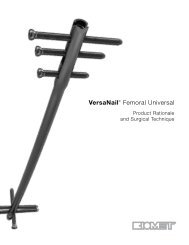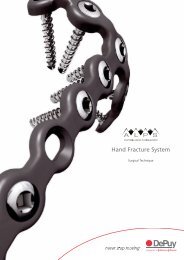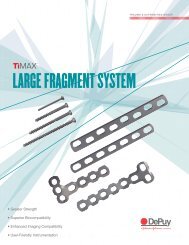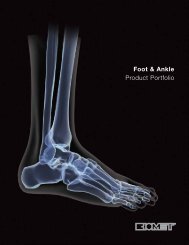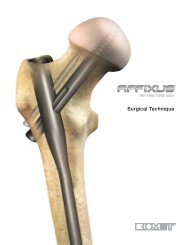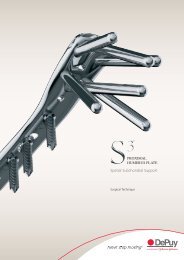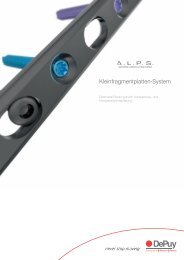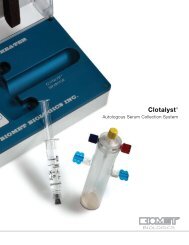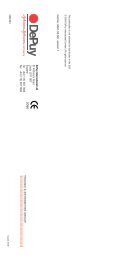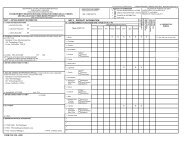DVR Anatomic Plate Clinical Summaries - Biomet
DVR Anatomic Plate Clinical Summaries - Biomet
DVR Anatomic Plate Clinical Summaries - Biomet
You also want an ePaper? Increase the reach of your titles
YUMPU automatically turns print PDFs into web optimized ePapers that Google loves.
<strong>DVR</strong> ® <strong>Anatomic</strong> <strong>Plate</strong><br />
A 10 year landmark<br />
in clinical evidence<br />
<strong>Clinical</strong> <strong>Summaries</strong>
0612-22-000 <strong>Clinical</strong> <strong>Summaries</strong>.FINAL.indd 3 5/8/10 08:42:16
Evaluating the Evidence<br />
Summary<br />
This selection of key studies is designed to provide an overview of clinical investigations involving the<br />
<strong>DVR</strong> ® <strong>Anatomic</strong> <strong>Plate</strong>. These clinical summaries provide the evidence for its ease-of-use and biomechanical<br />
strengths, demonstrating 10 years of clinical success for the <strong>DVR</strong> ® <strong>Anatomic</strong> <strong>Plate</strong> and providing support<br />
for its strong heritage.<br />
Each of these clinical summaries will provide an excellent grounding for discussions with customers and<br />
can be selected individually based on their key messages, as outlined in the executive summary.<br />
Glossary and normal values<br />
Patient Tests<br />
Grip strength 1<br />
Range of motion tests:<br />
Measured using hand dynamometers, measurements are reported in comparison with the uninjured hand. One<br />
study showed 100% grip strength in dominant hands after two years’ follow-up; however, in cases where the<br />
non-dominant side was injured, strength reached less than 80%.<br />
Normal values vary between individuals, so comparison with the healthy side can be more appropriate than use<br />
of population norms.<br />
Pronation 2 Rotation of the hand so that the palm faces backwards or downwards. Normal range 85°–90°.<br />
Supination 2 Rotation of the hand so that the palm faces forward or upward Normal range 85°–90°.<br />
Flexion 2 Bending wrist so palm faces downward. Normal range 80°–90°.<br />
Extension 2 Bending wrist so palm faces forward. Normal range 70°–90°.<br />
Radio-ulnar deviation 2<br />
Bending of the wrist along the horizontal plane in the direction of the radius (normal value 15°) or ulna (normal<br />
range 30°–45°).<br />
Patient-rated Measures<br />
Disabilities of the Arm, Shoulder<br />
and Hand (DASH) score 3<br />
Mayo Modified Wrist Score<br />
(MMWS) 4<br />
Michigan Hand Outcomes<br />
Questionnaire (MHOQ) 5<br />
Jebsen-Taylor hand function test 6<br />
Measured using hand dynamometers, measurements are reported in comparison with the uninjured hand. One<br />
study showed 100% grip strength in dominant hands after two years’ follow-up; however, in cases where the<br />
non-dominant side was injured, strength reached less than 80%.<br />
More objective assessment of pain, work status, range of motion and grip strength. Each section is scored out of<br />
25, giving a total score out of 100.<br />
Measures patient function, pain and satisfaction using six scales: overall hand function, activities of daily living,<br />
work performance, pain, aesthetics and satisfaction with hand function. The raw score is converted to a score<br />
out of 100.<br />
A seven-part test of normal hand function, including writing and picking up small objects.<br />
Figure 1<br />
X-ray Tests<br />
Volar tilt 7 Figure 1, angle between line V and line W. Normal volar tilt averages 11° (range 2°–20°).<br />
Radial tilt/inclination 7 Figure 2, angle of line EC and line DC (normal range, 21°–25°).<br />
Radial shortening 7<br />
Figure 2, radial height is the distance between points D and E. Normal length is 10–13 mm, for estimation of<br />
shortening, measurements should be compared with the uninjured wrist. Surgeons aim for less than 2 mm<br />
shortening.<br />
Figure 2<br />
Images reproduced from Goldfarb CA. Radiology 2001;219:11–28<br />
1<br />
0612-22-000 <strong>Clinical</strong> <strong>Summaries</strong>.FINAL.indd 1 5/8/10 08:42:16
Volar fixed-angle plate fixation<br />
for unstable distal radius fractures<br />
in the elderly patient<br />
Orbay et al. J Hand Surg 2004;29A:96–102<br />
Level of evidence<br />
This is a level IV study as it is a retrospective case series by a product developer.<br />
Objective<br />
Distal radius fractures are a major cause of morbidity for elderly patients. The <strong>DVR</strong> ® <strong>Anatomic</strong> <strong>Plate</strong> has<br />
previously been shown to provide benefits for younger patients; therefore, this study tested its effectiveness<br />
in treating unstable distal radius fractures in the elderly osteoporotic population.<br />
Study design<br />
Patients aged ≥75 years with unstable distal radius fractures<br />
that had been treated with the DePuy <strong>DVR</strong> ® <strong>Anatomic</strong> <strong>Plate</strong> at<br />
2 separate institutions (Miami Hand Center in Miami, USA and<br />
Lindenhof Hospital in Berne, Switzerland) were retrospectively<br />
reviewed. Twenty-three consecutive patients were included.<br />
Twenty were treated as outpatients, 18 under regional and two<br />
under general anaesthesia. Radiographic and functional results<br />
were reviewed at the final evaluation. Wrist, forearm and digital<br />
motion, and grip strength were assessed. Residual pain was<br />
graded, and radiographs were assessed according to Castaing.<br />
For outcome assessment, the DASH test was given at 1 year<br />
follow up.<br />
Additional information<br />
Only the <strong>DVR</strong> ® <strong>Anatomic</strong> <strong>Plate</strong> product was studied. This study<br />
was performed by one of the <strong>DVR</strong> ® designing surgeons.<br />
Results<br />
• Patients were followed-up for a mean of 63 weeks (range<br />
53-98 weeks).<br />
• The DASH disability/symptom score averaged 8.28 in the<br />
series, with 1-year results suggesting a high degree of<br />
patient satisfaction.<br />
• The majority (63%) of patients did not have any form of<br />
bone grafting and autologous graft was not used in any<br />
patient.<br />
• Restoration of the volar tilt, ulnar inclination and articular<br />
congruency was highly satisfactory.<br />
• There were no plate failures or significant loss of reduction.<br />
®<br />
• The <strong>DVR</strong> <strong>Anatomic</strong> <strong>Plate</strong> was left in place in all cases, with<br />
no incidence of infection or implant failure.<br />
• One complication occurred; transient regional pain<br />
syndrome with delayed recovery of digital motion, which<br />
responded to therapy<br />
2<br />
Recovery<br />
Time<br />
Patients were<br />
able to perform<br />
activities of<br />
daily living<br />
by 2 weeks<br />
after surgery<br />
and regained<br />
their pre-injury<br />
activity levels.<br />
Pain<br />
At final<br />
evaluation, 19<br />
patients were<br />
free of pain,<br />
two had mild<br />
pain and two<br />
had moderate<br />
pain (defined as<br />
occurring under<br />
heavy manual<br />
labour)<br />
Radiographic<br />
findings<br />
Mean volar tilt<br />
was 6° and radial<br />
tilt 20°<br />
Radial shortening<br />
averaged less than<br />
1 mm<br />
The average time<br />
to radiographic<br />
union was 7.1<br />
weeks<br />
Range of<br />
motion and<br />
strength<br />
The mean final<br />
dorsiflexion<br />
was 58°, volar<br />
flexion 55°,<br />
pronation 80°,<br />
and supination<br />
76°<br />
Grip strength<br />
was 77% of the<br />
contralateral<br />
side<br />
Discussion<br />
Treatment of unstable distal radius fracture with the <strong>DVR</strong> ®<br />
<strong>Anatomic</strong> <strong>Plate</strong> minimised morbidity in the elderly population<br />
by allowing an early return to function. Treatment of unstable<br />
distal radius fractures in elderly patients is a serious problem<br />
due to anaesthetic risks in this group and osteoporotic bone.<br />
The <strong>DVR</strong> ® <strong>Anatomic</strong> <strong>Plate</strong> successfully handled osteopenic bone,<br />
allowed early return to function, provided good final results,<br />
and presented a low complication rate.<br />
Unstable fractures and those with articular displacement<br />
were adequately reduced and fixed. When necessary, this<br />
was accomplished using the extended flexor carpi radialis<br />
approach with thorough fracture debridement and fragment<br />
manipulation.<br />
Subchondral support pegs do not induce interfragmentary<br />
compression but firmly maintain bony alignment and rely on<br />
the substantial healing capability of the distal radius. The <strong>DVR</strong> ®<br />
<strong>Anatomic</strong> <strong>Plate</strong> does not require screw purchase into the distal<br />
fragment and is therefore less likely to loosen and toggle.<br />
0612-22-000 <strong>Clinical</strong> <strong>Summaries</strong>.FINAL.indd 2 5/8/10 08:42:16
In this study, absence of settling appeared to depend on accurate placement of the distal pegs in the immediate subchondral<br />
position and not with the use of bone graft.<br />
Final functional outcome of the patients are comparable to other reported series of open reduction internal fixation in<br />
non-elderly patients.<br />
Strengths / limitations<br />
This study was carried out in two centres, and the findings may not be generalisable to all other centres. However, the<br />
applicability is increased by the inclusion of both US and European settings. This study has some limitations, including a<br />
relatively low number of patients and the lack of a comparator group.<br />
KEY points for <strong>DVR</strong> ® <strong>Anatomic</strong> <strong>Plate</strong><br />
A successful design allowing:<br />
• Positive results in osteoporotic bone due to fixed-angle pegs<br />
• Subchondral support pegs do not induce interfragmentary compression but firmly maintain bony alignment, directly<br />
supporting the articular surface and preventing loss of fixation<br />
• Stable fixation<br />
• Fast return to function, even for elderly osteoporotic patients with unstable fractures<br />
THE BOTTOM LINE<br />
The <strong>DVR</strong> ® <strong>Anatomic</strong> <strong>Plate</strong> provided stability and a fast return to function in elderly patients.<br />
3<br />
0612-22-000 <strong>Clinical</strong> <strong>Summaries</strong>.FINAL.indd 3 5/8/10 08:42:16
Complex fractures of the distal radius<br />
treated with angular stability plates<br />
Frattini et al. Musculoskelet Surg 2009;93:155–162<br />
Level of evidence<br />
This is a level IV study as it is a prospective case series.<br />
Objective<br />
This study aimed to assess the effectiveness of the <strong>DVR</strong> ® <strong>Anatomic</strong> <strong>Plate</strong> for complex fractures of the<br />
distal radius.<br />
Study design<br />
Forty-eight complex distal radius fractures (AO classification<br />
type C) were treated with the DePuy <strong>DVR</strong> ® <strong>Anatomic</strong> <strong>Plate</strong>.<br />
Radiographs were performed on admission, post-operatively<br />
and at final follow-up. X-rays were analysed by measuring radial<br />
height, radial slope angle and volar tilt. Patients were assessed<br />
before and ≥1 year after surgery using the Italian version of the<br />
Disabilities of the Arm, Shoulder and Hand (DASH) score and<br />
the Mayo Modified Wrist Score (MMWS). Range of motion and<br />
grip strength were also assessed.<br />
Additional information<br />
Only the <strong>DVR</strong> ® <strong>Anatomic</strong> <strong>Plate</strong> double screw row model was<br />
studied.<br />
Results<br />
• Patients had a mean age of 52.5 years (range 25-82 years)<br />
and were followed-up for a mean of 26 months (range<br />
12-36 months)<br />
Recovery<br />
Time<br />
The average<br />
time to fracture<br />
healing was 2.6<br />
months.<br />
Pain<br />
Mean MMWS<br />
was 82.5/100.<br />
Six patients<br />
scored poorly, 6<br />
acceptable, 12<br />
were good and<br />
24 excellent.<br />
The overall<br />
DASH score was<br />
unavailable due<br />
to incomplete<br />
patient<br />
questionnaires.<br />
Radiographic<br />
findings<br />
Post-consolidation<br />
findings<br />
summarised as<br />
a single score:<br />
poor in 2 cases;<br />
sufficient, 7; good,<br />
24 and excellent,<br />
15. Mean radius<br />
height, 8.8 mm;<br />
radial slope, 22.4°;<br />
volar tilt, 9.7°.<br />
Range of<br />
motion and<br />
strength<br />
Final mean<br />
ROM was 60.5°<br />
in flexion ,<br />
extension 62.5°,<br />
radio-ulnar<br />
deviation<br />
40°, forearm<br />
pronation 88°<br />
and supination<br />
83°.<br />
Final grip<br />
strength was<br />
85% of the<br />
contralateral<br />
uninjured wrist.<br />
• Seven (14.6%) patients underwent a second surgery for<br />
capsule-ligamentous lesions undiagnosed at the time of<br />
injury, at an average of 11 months from the first surgery –<br />
all complications are acknowledged by the authors as being<br />
due to technical errors<br />
• In one case, the plate was later removed as a precautionary<br />
measure, where an excessively long <strong>DVR</strong> ® <strong>Anatomic</strong> <strong>Plate</strong><br />
was implanted in a professional motorcyclist<br />
Discussion<br />
The <strong>DVR</strong> ® <strong>Anatomic</strong> <strong>Plate</strong> ensured excellent stability in<br />
comminuted fractures and severe articular fractures, and<br />
demonstrated high tolerability due to its low profile anatomy.<br />
The study authors stated that the <strong>DVR</strong> ® <strong>Anatomic</strong> <strong>Plate</strong> holds<br />
specific biomechanical properties due to the distal positioning<br />
of the screws and pegs, which lie over a subchondral zone<br />
at the distal portion of the system. The locking pegs stabilise<br />
the subchondral bone while threaded screws capture the<br />
dorsal fragment and compress it against the radius. The layout<br />
of screws/pegs fan out on a frontal plane, and two rows of<br />
holes allow a 3D subchondral meshed support for the distal<br />
articular surface. Fixation of the radial styloid is also achieved.<br />
Furthermore, precise distal positioning of the pegs and screws<br />
significantly increases the synthesis stability of the fracture in<br />
comparison to a more proximal positioning. In addition, the<br />
study authors suggest that the <strong>DVR</strong> ® <strong>Anatomic</strong> <strong>Plate</strong> has a low<br />
level of difficulty for the surgeon.<br />
4<br />
0612-22-000 <strong>Clinical</strong> <strong>Summaries</strong>.FINAL.indd 4 5/8/10 08:42:16
Strengths / limitations<br />
No patients were lost to follow-up. The single centre setting of this study provides consistency; however, the findings of this<br />
group might not be generalisable elsewhere. The fact that one of the clinical outcome scores (DASH) were not adequately<br />
completed by some patients is a limitation.<br />
KEY points for <strong>DVR</strong> ® <strong>Anatomic</strong> <strong>Plate</strong><br />
A successful design including:<br />
®<br />
• Excellent stability due to specific distal peg and screw positioning over a subchondral zone, unique to the <strong>DVR</strong> <strong>Anatomic</strong><br />
<strong>Plate</strong> design<br />
• A low-profile plate which reduces friction with surrounding soft tissues and prevents hardware removal after bone<br />
consolidation<br />
• Two rows of pegs that provide subchondral support for the distal articular fragment<br />
• Good grip of the radial styloid<br />
• Good plate tolerability<br />
• A low level of surgical difficulty for implantation<br />
THE BOTTOM LINE<br />
The unique design of the <strong>DVR</strong> ® <strong>Anatomic</strong> <strong>Plate</strong> provided stability for comminuted fractures and a low<br />
level of surgical difficulty.<br />
5<br />
0612-22-000 <strong>Clinical</strong> <strong>Summaries</strong>.FINAL.indd 5 5/8/10 08:42:16
Treatment of unstable distal radius<br />
fractures with the volar locking<br />
plating system<br />
Chung et al. J Bone Joint Surg Am 2006;88:2687–2694<br />
Level of evidence<br />
This is a level IV study as it is a prospective case series.<br />
Objective<br />
The best treatment for inadequately reduced fractures of the distal radius is not well established. This study<br />
aimed to prospectively assess patients undergoing open reduction and internal fixation of inadequately<br />
reduced distal radius fractures using the <strong>DVR</strong> ® <strong>Anatomic</strong> <strong>Plate</strong>.<br />
Study design<br />
Consecutive patients with inadequately reduced distal radius<br />
fractures underwent open reduction and internal fixation using<br />
the <strong>DVR</strong> ® <strong>Anatomic</strong> <strong>Plate</strong> combined with an early motion<br />
rehabilitation protocol. Inclusion criteria were broad to make<br />
the cohort as representative as possible. Outcomes were<br />
assessed at 3, 6 and 12 months post-surgery. Radiographs were<br />
taken at each visit and the degree of fracture displacement<br />
was assessed. Hand strength (grip and lateral pinch) as<br />
well as wrist and forearm range of motion were measured,<br />
and the Jebsen-Taylor hand function test performed. The<br />
primary outcome measure was the Michigan Hand Outcomes<br />
Questionnaire (MHOQ).<br />
Additional information<br />
Only the <strong>DVR</strong> ® <strong>Anatomic</strong> <strong>Plate</strong> double screw row model was<br />
studied.<br />
Results<br />
• Of 161 procedures performed, 17 were ineligible and 87<br />
patients were enrolled. 18 patients were lost to<br />
follow-up after the 3 month assessment<br />
• Patients had a mean age of 48.9 years (range 18-83 years)<br />
• Eight patients had nine short-term complications, including<br />
one transient nerve dysfunction, five suture abscesses,<br />
two incision blisters and one hematoma. Two patients<br />
experienced complications related to intubation<br />
• The positive Jebsen-Taylor hand function test results were<br />
described as ‘exceptional’<br />
Discussion<br />
The <strong>DVR</strong> ® <strong>Anatomic</strong> <strong>Plate</strong> has been shown to be reliable for<br />
unstable distal radius fracture fixation. It has the advantage of<br />
providing comfort in early finger and wrist motion initiation. In<br />
the present study, fracture reduction was maintained despite<br />
early motion rehabilitation, which allowed the patient to quickly<br />
regain independence in daily activities.<br />
Recovery<br />
Time<br />
Pain<br />
Radiographic<br />
findings<br />
Range of<br />
motion and<br />
strength<br />
The locking screw design stabilises screws against toggle and<br />
resists loosening, providing additional strength by constructing<br />
The<br />
Jebsen-Taylor<br />
test showed<br />
94% regain of<br />
the activities<br />
of daily living<br />
compared to<br />
the contralateral<br />
side by 3<br />
months.<br />
The final mean<br />
overall MHOQ<br />
score was<br />
85.4/100.<br />
MHOQ results<br />
showed<br />
outcomes which<br />
were not as<br />
good as the<br />
contralateral<br />
side at 1 year,<br />
but patients had<br />
excellent ability<br />
to perform<br />
daily tasks by 3<br />
months.<br />
Values reported as<br />
displacement from<br />
normal values. At<br />
3 months, radial<br />
inclination was<br />
4°, volar angle<br />
was 4°, and radial<br />
shortening was<br />
2mm.<br />
Final mean<br />
ROM at 1 year<br />
follow up was<br />
58° in flexion ,<br />
extension 60.5°,<br />
ulnar deviation<br />
31.2°, radial<br />
deviation 19.4°,<br />
pronation 78.6°<br />
and supination<br />
79.6°.<br />
Lateral pinch<br />
was 97% and<br />
grip strength<br />
78.7% of the<br />
contralateral<br />
side after 1 year<br />
a scaffold under the articular surface. The proximal diaphyseal<br />
screws fix strongly into thick cortical bone.<br />
Few complications were observed, and these were superficial<br />
and not related to the plate. The study authors conclude<br />
that continued use of the plate is supported by the excellent<br />
outcomes data.<br />
6<br />
0612-22-000 <strong>Clinical</strong> <strong>Summaries</strong>.FINAL.indd 6 5/8/10 08:42:16
Strengths / limitations<br />
This study’s main strength is the inclusion of a relatively large number of prospectively assessed patients. The single centre<br />
setting with experienced users provides consistency; however, it should be noted that the findings of this group might not be<br />
applicable elsewhere.<br />
One limitation of this study is the lack of a comparator group. In addition, some patients were lost to follow-up in the early<br />
post operative period, which is not unusual given the study’s prospective design in a trauma population.<br />
KEY points for <strong>DVR</strong> ® <strong>Anatomic</strong> <strong>Plate</strong><br />
A successful design including:<br />
• Excellent construct stability due to locking peg and screw design<br />
• A fast return to function due to patient comfort in early rehabilitation exercises<br />
THE BOTTOM LINE<br />
As noted by the study authors, the <strong>DVR</strong> ® <strong>Anatomic</strong> <strong>Plate</strong> has been shown to be reliable for distal radius<br />
fracture fixation when used for the treatment of inadequately reduced distal radius fractures.<br />
7<br />
0612-22-000 <strong>Clinical</strong> <strong>Summaries</strong>.FINAL.indd 7 5/8/10 08:42:17
Comparative outcomes study using<br />
the volar locking plating system for<br />
distal radius fractures in both young<br />
adults and adults older than 60 years<br />
Chung et al. J Hand Surg 2008;33A:809–819<br />
Level of evidence<br />
This is a level II study as it is a prospective comparative study.<br />
Objective<br />
Comparative data assessing the eligibility of older patients for distal radius fracture treatments are lacking.<br />
This prospective study compared outcomes following use of the <strong>DVR</strong> ® <strong>Anatomic</strong> <strong>Plate</strong> between older and<br />
younger adults.<br />
Study design<br />
55 eligible consecutive patients with unilateral distal radius<br />
fractures and persistent deformity after unsuccessful closed<br />
reduction were assigned to two groups: 25 patients >60 years<br />
(older group), and 30 patients 20–40 years (younger group). All<br />
patients underwent open reduction and internal fixation using<br />
the <strong>DVR</strong> ® <strong>Anatomic</strong> <strong>Plate</strong>. Outcomes were assessed at 3, 6 and<br />
12 months post-surgery. Radiographs were taken at each visit<br />
and assessed by a blinded evaluator. Grip strength together<br />
with wrist and forearm range of motion were measured, and<br />
the Jebsen-Taylor test performed. Results were compared with<br />
normative values. The primary outcome measure was the<br />
Michigan Hand Outcomes Questionnaire (MHOQ).<br />
Additional information<br />
Only the <strong>DVR</strong> ® <strong>Anatomic</strong> <strong>Plate</strong> double screw row model was<br />
studied. The author refers to the <strong>DVR</strong> ® <strong>Anatomic</strong> <strong>Plate</strong> product<br />
as the volar locked plating system (VLPS).<br />
Results<br />
• Of 59 eligible patients recruited over 2 years, 55 were<br />
included in the final analysis at 12 months<br />
• Mean ages were: 69 years (older group, n=25) and 30 years<br />
(younger group, n=30)<br />
• Complication rates were similar between the two groups at<br />
all time points<br />
• Most complications were mild and no post-operative<br />
wrist deformities were observed<br />
• All complications that occurred were reported within the<br />
first 6 months post operative<br />
Recovery<br />
Time<br />
The younger<br />
group reached<br />
maximum<br />
recovery at 6<br />
months, while<br />
the older group<br />
continued to<br />
improve until<br />
their 12-month<br />
assessment.<br />
Pain<br />
No significant<br />
difference<br />
was observed<br />
between the<br />
groups for any<br />
outcome at any<br />
time-point.<br />
The Jebsen-Taylor<br />
test showed a<br />
trend towards a<br />
worse outcome<br />
in the older<br />
patient group.<br />
Twelve month<br />
MHOQ scores<br />
were: 85±18<br />
(older group) and<br />
82±18 (younger<br />
group).<br />
Radiographic<br />
findings<br />
At 3 months,<br />
radial inclination<br />
was 25°, volar tilt<br />
was 9° and radial<br />
height was 13mm<br />
in both groups.<br />
The 12 month<br />
results were<br />
similar.<br />
Range of<br />
motion and<br />
strength<br />
Pronation and<br />
supination were<br />
calculated vs.<br />
the uninjured<br />
side, and values<br />
were at or over<br />
90% at all time<br />
points.<br />
At 12 months,<br />
grip strength<br />
was 80% of the<br />
contralateral<br />
side in the<br />
younger group<br />
and 77% in the<br />
older group.<br />
Discussion<br />
The <strong>DVR</strong> ® <strong>Anatomic</strong> <strong>Plate</strong> was successful in managing distal<br />
radius fractures in older patients, yielding comparable results<br />
to younger patients. The results suggest no loss of fracture<br />
reduction due to the presence of osteopenia.<br />
Older patients reported extremely high satisfaction levels. This<br />
group took longer to recover but ultimately attained better<br />
outcomes than the younger patients.<br />
8<br />
0612-22-000 <strong>Clinical</strong> <strong>Summaries</strong>.FINAL.indd 8 5/8/10 08:42:17
Strengths / limitations<br />
The single centre setting of this study provides consistency; however, the findings of this group might not be applicable<br />
elsewhere. The study’s main strengths are the inclusion of prospectively assessed patients and a comparator group.<br />
The main limitation of this study is sub-optimal patient participation in the follow-up assessments, which is not unusual given<br />
the study’s prospective design.<br />
KEY points for <strong>DVR</strong> ® <strong>Anatomic</strong> <strong>Plate</strong><br />
A successful design showing:<br />
• Comparable results in older and younger patients, and extremely high patient satisfaction in both groups.<br />
• Success in the treatment of distal radius fractures in patients over 60 years of age.<br />
THE BOTTOM LINE<br />
The <strong>DVR</strong> ® <strong>Anatomic</strong> <strong>Plate</strong> provides excellent outcomes in both older and younger patients.<br />
9<br />
0612-22-000 <strong>Clinical</strong> <strong>Summaries</strong>.FINAL.indd 9 5/8/10 08:42:17
Volar fixation for dorsally angulated<br />
extra-articular fractures of the distal<br />
radius: A biomechanical study<br />
Koh et al. J Hand Surg 2006;31A:771–779<br />
Level of evidence<br />
NA (cadaver study)<br />
Objective<br />
This study aimed to compare the biomechanical properties of 5 volar plate fixation systems, consisting of 10<br />
different constructs in 2 types of fracture: the dorsal wedge and segmental resection osteotomy models.<br />
Study design<br />
Forty fresh-frozen cadaver radiuses received a 15 mm dorsally<br />
based wedge osteotomy and the volar cortex was fractured<br />
manually. These were divided into ten fixation groups (test 1). In<br />
another eight radiuses a 10 mm segment of bone was excised<br />
(test 2), and tested with four fixation systems. Cadaver hands<br />
and proximal radiuses were potted in polymethylmethacrylate<br />
and, after cyclic loading, were loaded to failure in axial<br />
compression at 2 mm/min. The stiffness, failure peak load and<br />
failure mode were recorded.<br />
Additional information<br />
Products used in this study were: Smith & Nephew, small T<br />
plate (group 1); Synthes, volar distal radius plate - Ti (group 2)<br />
and stainless steel (group 3); and LC small fragment locking<br />
compression plate (group 4); Avanta SCS volar plate large<br />
(group 5) and small (group 6) SCS volar plate; <strong>DVR</strong> ® <strong>Anatomic</strong><br />
<strong>Plate</strong> smooth (group 7) and threaded (group 8) peg, distal<br />
locking single proximal row; and <strong>DVR</strong> ® <strong>Anatomic</strong> <strong>Plate</strong> smooth<br />
(group 9) and threaded (group 10) peg, distal locking double<br />
row.<br />
Results<br />
• In groups 2 and 3 the distal pegs needed to pierce through<br />
the dorsal cortex<br />
• In groups 7–10 (<strong>DVR</strong> ®<br />
) the pegs were long enough to<br />
support the subchondral bone<br />
• In one of the four specimens tested, the distal locking<br />
screws of the LC plate disengaged from their screw holes.<br />
The locking systems (Synthes Ti, Synthes stainless steel,<br />
<strong>DVR</strong> ® groups) did not show distal fixation failure<br />
• The locking pegs of the Synthes Ti plates broke in both<br />
specimens tested<br />
®<br />
• The <strong>DVR</strong> <strong>Anatomic</strong> <strong>Plate</strong>s developed fractures between the<br />
peg hole and K-wire hole in 3 of 19 cases in test 1 and both<br />
plates used in test 2<br />
• These fractures did not appear to compromise fracture<br />
fixation during cyclic loading or load to failure testing<br />
Test 1: dorsally-based wedge<br />
osteotomy (all groups)<br />
All specimens completed the 5,000 cycles<br />
of loading with no failures<br />
The Smith & Nephew stainless steel T plate<br />
was the stiffest and the Synthes titanium<br />
plate the least stiff<br />
There was no significant difference<br />
between the 10 groups in failure peak<br />
load, although the <strong>DVR</strong> ® <strong>Anatomic</strong> <strong>Plate</strong><br />
with double row of threaded pegs (group<br />
10) scored highest<br />
Only 7 of 40 failed at the distal portion of<br />
the system in the final load to failure test<br />
Test 2: Segmental resection<br />
osteotomy (groups 1, 2, 6 and 9 only)<br />
Failure at the distal portion of the<br />
system was seen in 7 of 8 specimens<br />
Non-locking screws loosened and tines<br />
compressed the surrounding bone,<br />
leading to hole enlargement<br />
Discussion<br />
The results indicate that all of the ten plates are strong enough<br />
to support the bone in an uneventful post-operative early<br />
motion regimen. The study authors suggest that the thinness<br />
of the Synthes Ti plate resulted in it possessing the lowest<br />
average stiffness. The stainless steel plates were stiffer, and the<br />
thick titanium <strong>DVR</strong> ® <strong>Anatomic</strong> <strong>Plate</strong>s intermediate. Although<br />
the T plate offered better than expected stiffness, the large<br />
standard deviation of this plate suggests unpredictability in a<br />
clinical setting.<br />
10<br />
0612-22-000 <strong>Clinical</strong> <strong>Summaries</strong>.FINAL.indd 10 5/8/10 08:42:17
The LC plate (group 4) showed uncoupling in half of all cases, suggesting weaker fixation between the locking screws and<br />
plate than in the Synthes and <strong>DVR</strong> ® <strong>Anatomic</strong> <strong>Plate</strong>s, possibly due to smaller screw threads. The locking pegs of the Synthes<br />
and <strong>DVR</strong> ® <strong>Anatomic</strong> <strong>Plate</strong>s appeared to maintain fixation of the distal fragment very well without peg breakage. The <strong>DVR</strong> ®<br />
pegs are intended for subchondral positioning with volar unicortical fixation, and did not affect the surrounding bone. The<br />
authors suggest that the metal fracture seen in the <strong>DVR</strong> ® <strong>Anatomic</strong> <strong>Plate</strong> could indicate an inherently weak area.<br />
Strengths / limitations<br />
The main strength of this study is the variety of plates tested in order to demonstrate performance of the <strong>DVR</strong> ® <strong>Anatomic</strong> <strong>Plate</strong><br />
in comparison to competitor systems.<br />
The limitations include the qualitative rather than quantitative analysis used for the mode of fixation failure. In addition, there<br />
could be differences between the experimental loading and loading patterns seen in clinical situations.<br />
KEY points for <strong>DVR</strong> ® <strong>Anatomic</strong> <strong>Plate</strong><br />
A successful design allowing:<br />
• Sufficient support for an uneventful post-operative early motion regimen<br />
• Very good fixation due to locking pegs<br />
• Volar unicortical fixation without affecting surrounding bone<br />
NB. The peg-hole/K-wire fractures could indicate a weak are for the plate, but did not appear to compromise<br />
fixation (NB this failure mode has not been reported in other papers as a problem clinically).<br />
THE BOTTOM LINE<br />
The <strong>DVR</strong> ® <strong>Anatomic</strong> <strong>Plate</strong> provided good fixation due to the locking-peg design.<br />
11<br />
0612-22-000 <strong>Clinical</strong> <strong>Summaries</strong>.FINAL.indd 11 5/8/10 08:42:17
Percutaneous pins versus volar plates<br />
for unstable distal radius fractures: A<br />
biomechanic study using a cadaver model<br />
Knox et al. J Hand Surg 2007;32A:813–817<br />
Level of evidence<br />
NA (cadaver study)<br />
Objective<br />
This cadaver study compared the stability provided by pinning (K-wires) with that provided by the <strong>DVR</strong> ®<br />
<strong>Anatomic</strong> <strong>Plate</strong> for dorsally unstable distal radius fractures.<br />
Study design<br />
Unstable intra-articular fractures with dorsal comminution were<br />
created in seven fresh-frozen cadaver arms. This was achieved<br />
after thawing by removal of soft tissue followed by removal<br />
of a 30° dorsal wedge, then a sagittal cut extending from the<br />
dorsal wedge to the distal tip of the radius.<br />
Fixation of each sample was first tested using three 0.062<br />
inch K-wires in the standard cross configuration (Clancey<br />
technique). This configuration has been shown to be the most<br />
stable for unstable distal radius fracture fixation. The pins were<br />
then removed and fixation was tested with the DePuy <strong>DVR</strong> ®<br />
<strong>Anatomic</strong> <strong>Plate</strong>.<br />
Discussion<br />
Superior biomechanical stability was provided by the <strong>DVR</strong> ®<br />
<strong>Anatomic</strong> <strong>Plate</strong> when compared with percutaneous pinning.<br />
The study authors discuss the superior stiffness of the <strong>DVR</strong> ® ,<br />
<strong>Anatomic</strong> <strong>Plate</strong> which allows patients to begin early active<br />
range-of-motion. This permits the earlier, more aggressive<br />
rehabilitation that is important for favourable outcomes.<br />
The importance of restoring the joint with minimal incongruity<br />
is also discussed – this has been shown to be provided by the<br />
<strong>DVR</strong> ® <strong>Anatomic</strong> <strong>Plate</strong>.<br />
For both fixation types, increasing loads were applied to the<br />
tendons selectively, causing the wrist to flex or extend.<br />
The movement across the fracture site was measured using four<br />
K-wires and digital callipers.<br />
Results<br />
®<br />
• The <strong>DVR</strong> <strong>Anatomic</strong> <strong>Plate</strong> provided significantly more<br />
stability than pinning with crossed K-wires<br />
• Movement across the fracture site was more than<br />
halved with the <strong>DVR</strong> ® <strong>Anatomic</strong> <strong>Plate</strong> vs. pinning (1.1<br />
± 0.5 mm vs. 2.5 ± 1.3 mm, p= 0.024) – a statistically<br />
significant difference<br />
• Pins showed increasing displacement and notable<br />
slipping within the bone after repeat testing, which was<br />
not seen with the <strong>DVR</strong> ® <strong>Anatomic</strong> <strong>Plate</strong><br />
• The study was designed to test loads encountered<br />
during active rehabilitation, and none of the fixators<br />
failed during testing<br />
12<br />
0612-22-000 <strong>Clinical</strong> <strong>Summaries</strong>.FINAL.indd 12 5/8/10 08:42:17
Strengths / limitations<br />
The strengths of this study include the range of clinically-relevant loads used.<br />
The study is limited by the use of a cadaver model, which is necessary for this type of experiment but does not fully replicate<br />
in-patient effects.<br />
KEY points for <strong>DVR</strong> ® <strong>Anatomic</strong> <strong>Plate</strong><br />
The <strong>DVR</strong> ® <strong>Anatomic</strong> <strong>Plate</strong> provided:<br />
• More stable fixation compared with percutaneous pinning<br />
• No displacement or slipping within the bone, both of which were observed with pinning<br />
®<br />
• The superior stability provided by the <strong>DVR</strong> <strong>Anatomic</strong> <strong>Plate</strong> could allow early, more aggressive rehabilitation, and more<br />
favourable outcomes<br />
THE BOTTOM LINE<br />
Superior biomechanical stability is provided by the <strong>DVR</strong> ® <strong>Anatomic</strong> <strong>Plate</strong> when compared with<br />
percutaneous pinning. Stable fracture fixation enables proactive rehabilitation which could lead to<br />
improved patient outcomes.<br />
13<br />
0612-22-000 <strong>Clinical</strong> <strong>Summaries</strong>.FINAL.indd 13 5/8/10 08:42:17
Internal fixation of dorsally displaced<br />
fractures of the distal part of the<br />
radius. A biomechanical analysis<br />
of volar plate fracture stability<br />
Willis et al. J Bone Joint Surg Am 2006;88:2411–2417<br />
Level of evidence<br />
NA (Sawbones study)<br />
Objective<br />
This study compared the fixation stability provided by five distal radius plates (four volar and one dorsal),<br />
including the DePuy <strong>DVR</strong> ® <strong>Anatomic</strong> <strong>Plate</strong>, for dorsally comminuted distal radial/Colles type fractures.<br />
Study design<br />
A dorsally comminuted, unstable, extra-articular, distal fracture<br />
with an oblique gap was created in the distal part of the radius<br />
in 30 synthetic bone (Sawbones) preparations.<br />
The stiffness of five plates was compared using loading<br />
tests designed to mimic the forces applied during early<br />
post-operative hand and wrist mobilisation.<br />
Axial compression, dorsal bending and volar bending were<br />
tested with increasing loads.<br />
An additional section of bone was then removed to form a<br />
segmental bone gap and the tests repeated for the dorsal pi<br />
plate only.<br />
Additional information<br />
Products compared in this study were: (1) DePuy single-row<br />
<strong>DVR</strong> ® <strong>Anatomic</strong> <strong>Plate</strong>, (2) Synthes AO 3.5 mm small-fragment<br />
non-locking plate, (3) Synthes AO 3.5 mm small-fragment<br />
locking plate, (4) Synthes AO T-plate, and (5) Synthes AO pi<br />
plate. <strong>Plate</strong>s 1–4 are volar plates, while the pi plate is placed<br />
dorsally.<br />
Results<br />
Stiffness is defined as the amount of force (N) applied for<br />
each millimetre distance of motion. The pi plate without<br />
the additional fracture gap showed no motion in the axial<br />
compression test, so stiffness could not be calculated. This<br />
means that the pi plate without gap was automatically the<br />
‘stiffest’ in this test.<br />
Axial compression<br />
stiffness<br />
No significant difference<br />
between AO volar locking<br />
and <strong>DVR</strong> ® <strong>Anatomic</strong> <strong>Plate</strong>s<br />
AO volar locking plate<br />
was stiffer than AO volar<br />
non-locking, AO T-plate and<br />
pi-plate with gap (p
KEY points for <strong>DVR</strong> ® <strong>Anatomic</strong> <strong>Plate</strong><br />
The <strong>DVR</strong> ® <strong>Anatomic</strong> <strong>Plate</strong> provided:<br />
• Superior fracture stability versus non-locking plates<br />
• Similar fracture stability versus the AO locking plate<br />
• NB. The dorsal plate did provide the greatest stiffness; however, this approach has been associated with complications<br />
THE BOTTOM LINE<br />
In this study, the <strong>DVR</strong> ® locking plate was shown to provide stable volar fixation for dorsally displaced<br />
fractures of the distal radius. A volar approach could therefore be supported, even in situations where a<br />
fracture is dorsally displaced.<br />
15<br />
0612-22-000 <strong>Clinical</strong> <strong>Summaries</strong>.FINAL.indd 15 5/8/10 08:42:17
Biomechanical comparison of different<br />
volar fracture fixation plates for distal<br />
radius fracture<br />
Sobky et al. Hand 2008;3:96–101<br />
Level of evidence<br />
NA (Sawbones/cadaver study)<br />
Objective<br />
This study compared the fixation stability provided by four volar distal radius plates, including the DePuy<br />
<strong>DVR</strong> ® <strong>Anatomic</strong> <strong>Plate</strong>, for unstable distal radius fractures.<br />
Study design<br />
An unstable, extra-articular fracture with 10 mm gap was<br />
created in the distal part of the radius in synthetic bone<br />
(Sawbones) preparations. Six plates were tested for single-cycle<br />
load to failure for each plate-type. The resulting angle<br />
deformation of the plates was measured and recorded. Stiffness<br />
was calculated using the linear portion of a plot showing<br />
displacement (due to deformation) vs. load. A further six plates<br />
of each type were then subjected to cycles of loading and<br />
tested to failure as before. The loading in this test was based on<br />
physiological loads experienced during normal motion. Cadaver<br />
testing was performed using the single-cycle loading method to<br />
evaluate the mode of plate failure and validate the sawbones<br />
model, with two plates of each type tested.<br />
Additional information<br />
Products compared in this study were: (1) DePuy double-row<br />
<strong>DVR</strong> ® -A plate, (2) Avanta SCS/V plate, (3) Wright Medical<br />
Lo-Con VLS plate and (4) Synthes volar radius stainless steel<br />
locking plate.<br />
Results<br />
Stiffness is defined as the amount of force (N) applied for each<br />
millimetre distance of motion.<br />
Single-cycle loading (sawbones model)<br />
Failure load Angle deformation Stiffness<br />
<strong>DVR</strong> ® showed significantly<br />
higher load to failure than<br />
the other three plates<br />
(p
Strengths / limitations<br />
This study used a sawbones model, which is a validated synthetic bone-model but might not be fully equivalent to cadaver<br />
tests. However, the cadaver tests undertaken in this study produced similar results to sawbones, validating the model in this<br />
experiment. In addition, the use of sawbones provides consistency between samples. Neither model fully replicates in-patient<br />
results but this type of testing cannot be performed in patients.<br />
KEY points for <strong>DVR</strong> ® <strong>Anatomic</strong> <strong>Plate</strong><br />
In both single-cycle loading and more physiological cyclical loading tests, the <strong>DVR</strong> ® <strong>Anatomic</strong> <strong>Plate</strong> provided:<br />
• Significantly higher peak-load to failure<br />
• Significantly lower levels of deformation<br />
• Similar stiffness compared with the Synthes, Wright Medical and Avanta plates<br />
THE BOTTOM LINE<br />
When compared to competitive systems, the <strong>DVR</strong> ® demonstrates equivalent stiffness with significant<br />
advantages in terms of failure load and angle deformation in gap resected, dorsally displaced distal<br />
radius fractures. These biomechanical advantages could translate into a minimal likelihood of implant<br />
failure during post-operative mobilisation.<br />
17<br />
0612-22-000 <strong>Clinical</strong> <strong>Summaries</strong>.FINAL.indd 17 5/8/10 08:42:17
A biomechanical comparison of<br />
two volar locked plates in a dorsally<br />
unstable distal radius fracture model<br />
Liporace et al. J Trauma 2006;61:668–672<br />
Level of evidence<br />
NA (cadaver study)<br />
Objective<br />
This study compared the fixation stability provided by the <strong>DVR</strong> ® <strong>Anatomic</strong> <strong>Plate</strong> with that of the 3.5 mm<br />
Synthes stainless steel volar locked T-plate, for unstable distal radius fractures.<br />
Study design<br />
Six thawed matched pairs of fresh-frozen cadaver specimens<br />
were stripped of soft tissue and an unstable, extra-articular,<br />
wedge-resected distal radius fracture was created in each. One<br />
specimen from each pair was assigned to the <strong>DVR</strong> ® <strong>Anatomic</strong><br />
<strong>Plate</strong>, and the other to the Synthes plate.<br />
Five reference loading points were marked on each specimen;<br />
one central over the longitudinal axis of the radius and four<br />
off-centre points, 2 cm from the central point (volar, dorsal,<br />
radial and ulnar).<br />
A single-cycle axial load designed to replicate that experienced<br />
by the distal radius during grip was applied to each of these<br />
points.<br />
Specimens were then subjected to cyclical loading, designed to<br />
replicate physiological loading over six weeks.<br />
Finally, an additional single-cycle loading test (post-cyclical<br />
loading) was applied to each specimen.<br />
Results<br />
Stiffness is defined as the amount of force (N) applied for each<br />
millimetre distance of motion.<br />
• Single-cycle loading<br />
• No significant difference in stiffness was observed<br />
between the <strong>DVR</strong> ® <strong>Anatomic</strong> <strong>Plate</strong> and Synthes plates<br />
• Post-Cyclical loading<br />
®<br />
• The <strong>DVR</strong> <strong>Anatomic</strong> <strong>Plate</strong> was significantly stiffer to<br />
volar loading than the Synthes (p
The Synthes plate is thinner than the <strong>DVR</strong> ® <strong>Anatomic</strong> <strong>Plate</strong>, resulting in similar stiffness (given the inherently stiffer nature<br />
of stainless steel compared with titanium alloy). Titanium would provide higher quality MRI images, which favours the <strong>DVR</strong> ®<br />
<strong>Anatomic</strong> <strong>Plate</strong> over the Synthes plate in cases where this type of scan might be required.<br />
Strengths / limitations<br />
This study used a cadaver model, which does not fully replicate in-patient results. One reason for this is the removal of soft<br />
tissues. However, this type of testing cannot be performed in patients.<br />
KEY points for <strong>DVR</strong> ® <strong>Anatomic</strong> <strong>Plate</strong><br />
®<br />
• The superior stiffness of the <strong>DVR</strong> <strong>Anatomic</strong> <strong>Plate</strong> design may provide better fixation and enhanced stability to volar loading<br />
• Superior stiffness observed at the volar point could be due to the:<br />
• Divergent configuration and subchondral location of the distal pegs<br />
• Rafter support to the articular surface provided by the subchondral screw orientation<br />
®<br />
• Titanium alloy of the <strong>DVR</strong> <strong>Anatomic</strong> <strong>Plate</strong> provides higher quality MRI images<br />
THE BOTTOM LINE<br />
The superior stiffness observed on volar loading with the <strong>DVR</strong> ® <strong>Anatomic</strong> <strong>Plate</strong> could offer advantages in<br />
early patient mobilisation and recovery of grip strength.<br />
19<br />
0612-22-000 <strong>Clinical</strong> <strong>Summaries</strong>.FINAL.indd 19 5/8/10 08:42:17
Volar fixed-angle fixation of distal radius<br />
fractures: The <strong>DVR</strong> ® <strong>Anatomic</strong> <strong>Plate</strong><br />
Orbay et al. Tech Hand Upper Extrem Surg 2004;8:142–148<br />
Level of evidence<br />
This is a level V study as it is an expert opinion<br />
Objective<br />
This review describes the <strong>DVR</strong> ® <strong>Anatomic</strong> <strong>Plate</strong>, designed for the management of dorsal and volar displaced<br />
radial fractures from the volar approach.<br />
Additional information<br />
This review was authored by one of the <strong>DVR</strong> ® <strong>Anatomic</strong> <strong>Plate</strong><br />
designing surgeons.<br />
Historical perspective<br />
Fixed-angle plates were developed to provide internal<br />
buttressing to the bone. These plates included both dorsal and<br />
volar designs but initially, volar plating was mainly used for<br />
volar-displaced fractures. Dorsal plating was preferred for the<br />
more common dorsally-displaced fractures.<br />
The dorsal approach to internal fixation of distal radius<br />
fractures was associated with several problems, including<br />
the requirement for extensive dissection, fixation issues and<br />
extensor tendon problems. Therefore, the extended flexor carpi<br />
radialis (FCR) surgical approach and the <strong>DVR</strong> ® <strong>Anatomic</strong> <strong>Plate</strong><br />
were developed to allow fixation of dorsally-displaced fractures<br />
from the volar aspect. The <strong>DVR</strong> ® <strong>Anatomic</strong> <strong>Plate</strong> has been<br />
shown to be effective in both volarly and dorsally-displaced<br />
distal radius fractures, including those in osteoporotic patients.<br />
Indications/contraindications<br />
The technique is indicated for unstable distal radius fractures in<br />
which simpler forms of treatment would produce unacceptable<br />
results.<br />
Technique<br />
Simple, recent (less than 10 day-old) fractures can be treated<br />
using the standard FCR approach. More complex fractures<br />
require the extended FCR approach. The <strong>DVR</strong> ® <strong>Anatomic</strong> <strong>Plate</strong><br />
accepts fixed-angle K-wires that allow the surgeon to visualise<br />
the plane of the primary (proximal) peg row. The primary row<br />
of pegs provides the stability required for most fractures, and<br />
the secondary row provides improved fixation for certain cases.<br />
<strong>DVR</strong> ® <strong>Anatomic</strong> <strong>Plate</strong> features include:<br />
• Double row of fixed-angle pegs to support subchondral<br />
bone, creating a 3D scaffold for the entire articular surface<br />
• <strong>Anatomic</strong>ally designed volar buttressing system to support<br />
volar marginal fragments<br />
• Proximal/primary peg row directed obliquely from proximal<br />
to distal, supporting the dorsal side of the articular<br />
surface, effectively preventing dorsally-displaced fracture<br />
redisplacement<br />
• Proximal direction of the secondary peg-row, supporting the<br />
more central and volar sides of the subchondral bone<br />
• Low profile plate that can be positioned just proximal to the<br />
watershed line<br />
• K-wires aid in maintaining reduction and anticipate the final<br />
peg position<br />
Complications<br />
Most complications can be avoided with vigilance and care, but<br />
can include flexor tendon problems and dorsal tendon irritation.<br />
Rare complications include reflex sympathetic dystrophy and<br />
loss of reduction. Carpal tunnel syndrome and traumatic<br />
median neuropathies are common after distal radius fractures.<br />
Rehabilitation<br />
Proper rehabilitation is essential. Results vary between patients;<br />
however, full digital motion should be seen at or soon after the<br />
first post-operative visit. Recovery of full arm rotation can take<br />
4–6 weeks, while wrist flexion and extension usually plateau<br />
around the third or fourth month. Full recovery is a reasonable<br />
goal for these factors, and fracture healing usually occurs<br />
between the fourth and tenth week.<br />
20<br />
0612-22-000 <strong>Clinical</strong> <strong>Summaries</strong>.FINAL.indd 20 5/8/10 08:42:17
KEY points for <strong>DVR</strong> ® <strong>Anatomic</strong> <strong>Plate</strong><br />
®<br />
• The design of the <strong>DVR</strong> <strong>Anatomic</strong> <strong>Plate</strong> includes key features for improved stability, including:<br />
• Double row of fixed-angle pegs to support subchondral bone, creating a 3D scaffold for the entire articular surface<br />
• <strong>Anatomic</strong>ally designed volar buttressing system to support volar marginal fragments<br />
• Extra support provided by oblique/proximal direction of primary and secondary peg-rows<br />
• K-wires aid in maintaining reduction, help in plate positioning and anticipate final peg position<br />
• Complications are avoidable<br />
THE BOTTOM LINE<br />
The <strong>DVR</strong> ® <strong>Anatomic</strong> <strong>Plate</strong> is designed to accurately restore natural anatomy and provide support for<br />
healing and early mobilisation. This could translate into improved patient outcomes.<br />
21<br />
0612-22-000 <strong>Clinical</strong> <strong>Summaries</strong>.FINAL.indd 21 5/8/10 08:42:17
<strong>DVR</strong> ® <strong>Anatomic</strong> <strong>Plate</strong> <strong>Clinical</strong> <strong>Summaries</strong> – Executive Summary<br />
Key Messages Supporting <strong>Clinical</strong> Claims Refe<br />
Early mobilisation<br />
Stiffness & stability<br />
Ease of use<br />
The superior stiffness observed on volar loading with the <strong>DVR</strong> ® <strong>Anatomic</strong><br />
<strong>Plate</strong> could offer advantages in early patient mobilisation and recovery of grip<br />
strength.<br />
The <strong>DVR</strong> ® <strong>Anatomic</strong> <strong>Plate</strong> is designed to accurately restore natural anatomy<br />
and provide support for healing and early mobilisation. This could translate<br />
into improved patient outcomes.<br />
As noted by the study authors, the <strong>DVR</strong> ® <strong>Anatomic</strong> <strong>Plate</strong> has been shown to<br />
be reliable for distal radius fracture fixation when used for the treatment of<br />
initially inadequately reduced distal radius fractures.<br />
The <strong>DVR</strong> ® <strong>Anatomic</strong> <strong>Plate</strong> provided stability and a fast return to function in<br />
elderly patients.<br />
The <strong>DVR</strong> ® <strong>Anatomic</strong> <strong>Plate</strong> provides excellent outcomes in both older and<br />
younger patients.<br />
When compared to competitive systems, the <strong>DVR</strong> ® <strong>Anatomic</strong> <strong>Plate</strong><br />
demonstrates equivalent stiffness with significant advantages in terms of<br />
failure load and angle deformation in gap resected, dorsally displaced distal<br />
radius fractures. These biomechanical advantages might translate into a<br />
minimal likelihood of implant failure during post-operative mobilisation.<br />
Superior biomechanical stability is provided by the <strong>DVR</strong> ® <strong>Anatomic</strong> <strong>Plate</strong><br />
when compared with percutaneous pinning. Stable fracture fixation enables<br />
proactive rehabilitation which could lead to improved patient outcomes.<br />
The <strong>DVR</strong> ® locking plate was shown to provide stable volar fixation for dorsally<br />
displaced fractures of the distal radius. A volar approach could therefore be<br />
supported, even in situations where a fracture is dorsally displaced.<br />
The <strong>DVR</strong> ® <strong>Anatomic</strong> <strong>Plate</strong> provided good fixation due to the locking-peg<br />
design.<br />
The unique design of the <strong>DVR</strong> ® <strong>Anatomic</strong> <strong>Plate</strong> provided stability for<br />
comminuted fractures and a low level of surgical difficulty.<br />
A bio<br />
unsta<br />
Lipo<br />
Volar<br />
Orba<br />
Treat<br />
syste<br />
Chun<br />
Volar<br />
patie<br />
Orba<br />
Com<br />
dista<br />
Chun<br />
Biom<br />
dista<br />
Sobk<br />
Percu<br />
A bio<br />
Kno<br />
Inter<br />
radiu<br />
Willi<br />
Volar<br />
radiu<br />
Koh<br />
Com<br />
Fratt<br />
22<br />
0612-22-000 <strong>Clinical</strong> <strong>Summaries</strong>.FINAL.indd 22 5/8/10 08:42:17
Reference Paper<br />
Level of Evidence<br />
rip<br />
o<br />
l<br />
A biomechanical comparison of two volar locked plates in a dorsally<br />
unstable distal radius fracture model<br />
Liporace et al. J Trauma 2006;61:668–672.<br />
Volar fixed-angle fixation of distal radius fractures: The <strong>DVR</strong> ® plate<br />
Orbay et al. Techniques Hand Up Extrem Surg 2004;8:142–148.<br />
Treatment of unstable distal radius Fx with the volar locking plating<br />
system<br />
Chung et al. J Bone Joint Surg Am 2006;88:2687–2694.<br />
Volar fixed angle plate fixation for unstable distal radius Fx in the elderly<br />
patient<br />
Orbay et al. J Hand Surg 2004;29A:96–102.<br />
Comparative outcomes study using the volar locking plating system for<br />
distal radius fractures in both young adults and adults older than 60 years<br />
Chung et al. J Hand Surg 2008;33A:809–819.<br />
Biomechanical comparison of different volar fracture fixation plates for<br />
distal radius fractures<br />
Sobky et al. Hand 2008;3:96–101.<br />
NA (cadaver study)<br />
Level V (expert opinion)<br />
Level IV (case series, no<br />
comparator group)<br />
Level IV (case series, no<br />
comparator group)<br />
Level II<br />
NA (sawbones/<br />
cadaver study)<br />
s<br />
lly<br />
Percutaneous pins versus volar plates for unstable distal radius fractures:<br />
A biomechanic study using a cadaver model<br />
Knox et al. J Hand Surg 2007;32A:813–817.<br />
Internal fixation of dorsally displaced fractures of the distal part of the<br />
radius. A biomechanical analysis of volar plate fracture stability<br />
Willis et al. J Bone Joint Surg Am 2006;88:2411–2417.<br />
Volar fixation for dorsally angulated extra-articular fractures of the distal<br />
radius: A biomechanical study<br />
Koh et al. J Hand Surg 2006;31A:771–779.<br />
Complex fractures of the distal radius treated with angular stability plates<br />
Frattini et al. Musculoskelet Surg 2009;93:155–162.<br />
NA (cadaver study)<br />
NA (sawbones study)<br />
NA (cadaver study)<br />
IV (case series, no<br />
comparator group)<br />
23
Appendix I – Levels of Evidence<br />
Levels of Evidence for Primary Research Question i<br />
Therapeutic Studies – Investigating the Results of Treatment<br />
Level I<br />
Level II<br />
Level III<br />
Level IV<br />
Level V<br />
• High-quality randomised controlled trial with statistically significant difference or no statistically<br />
significant difference but narrow confidence intervals<br />
ii<br />
• Systematic review of Level-I randomised controlled trials (and study results were<br />
homogeneous iii )<br />
• Lesser-quality randomised controlled trial (e.g.,
Notes<br />
0612-22-000 <strong>Clinical</strong> <strong>Summaries</strong>.FINAL.indd 25 5/8/10 08:42:18
References<br />
1. Lagerström C, Nordgren B, Rahme H. Recovery of isometric grip strength after Colles' fracture: a prospective two-year study. J<br />
Rehab Med 1999;31:55-62.<br />
2. Magee DJ. Forearm, wrist and hand. Orthopedic physical assessment, 5th edition. St. Louis, MO: Saunders Elsevier; 2008. p.<br />
396-470.<br />
3. Institute for Work and Health. The DASH outcome measure. http://www.dash.iwh.on.ca/ (Accessed 20 April 2010).<br />
4. Carter PB, Stuart PR. The Sauve-Kapandji procedure for post-traumatic disorders of the distal radio-ulnar joint. J Bone Joint Surg<br />
Br 2000;82:1013-1018.<br />
5. University of Michigan Medical School. Michigan Hand Outcomes Questionnaire. http://sitemaker.umich.edu/mhq/overview (Accessed<br />
20 April 2010).<br />
6. Davis Sears E, Chung KC. Validity and responsiveness of the Jebsen-Taylor Hand Function Test. J Hand Surg;35:30-37.<br />
7. Goldfarb CA, Yin Y, Gilula LA, Fisher AJ, Boyer MI. Wrist fractures: what the clinician wants to know. Radiology 2001;219:11-28.<br />
This publication is not intended for distribution in the USA.<br />
<strong>DVR</strong> ® <strong>Anatomic</strong> <strong>Plate</strong> is a registered trademark of DePuy Orthopaedics, Inc.<br />
© 2011 DePuy International Limited. All rights reserved.<br />
Registered Office: St. Anthony’s Road, Leeds LS11 8DT, England.<br />
Registered in England No. 3319712<br />
Cat No: 0612-22-000 version 1<br />
DePuy International Ltd<br />
St. Anthony’s Road<br />
Leeds LS11 8DT<br />
England<br />
Tel: +44 (0)113 387 7800<br />
Fax: +44 (0)113 387 7890<br />
0086<br />
Revised: 05/11




